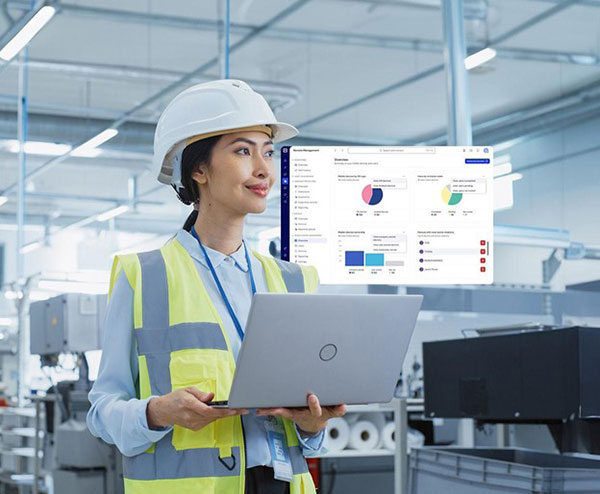Volume 27 | Issue 4
Click here to read the complete illustrated article or continue below to read the text article.
By Matthew Wyatt
Imagine a high-precision manufacturing plant where machines must operate with exact calibration. To do so, its IT systems monitor equipment vibration and calibration data closely to detect when a machine drifts out of tolerance. However, when they find issues, they are not communicated to the technicians in front of the actual machines. The technicians therefore remain unaware of these issues and are unable to solve them, leading to flawed products and costly rework. By the time they discover the problem, it’s too late.
This is the reality for many factories with disconnected IT and OT teams. IT holds the data to predict issues, while OT manages operations. Without bridging these worlds, on-site technicians are unable to take action.
A recent survey found that 90% of businesses report their IT and OT teams are isolated. Bridging this gap is more than improving efficiency, cost savings and quality – it’s about empowering frontline workers. When IT and OT work in sync, technicians receive real-time alerts, allowing them to adjust calibration before problems escalate. This integration increases employee engagement, prevents downtime and reduces waste.
Integrating IT and OT ensures that machines, data and personnel work together seamlessly, driving efficiency and giving businesses a competitive edge.
A recent study highlighted that a lack of connection between IT and OT leaves behind an immense amount of potential, such as failure to train teams together, integrate data or align their strategies. That’s because too many organizations keep these departments siloed. Nearly half (47%) of the leaders surveyed say their IT and OT teams aren’t even on the same page when it comes to cybersecurity – a necessity for keeping businesses safe and secure.
Syncing IT/OT offers companies predictive maintenance, faster reaction times to market changes, and even reduced energy use, with fewer breakdowns, more streamlined operations, and a happier workforce.
With that comes reduced costs, increased revenue, improved operational performance, greater agility and so much more.
It seems like an obvious decision to connect IT and OT, but the barriers are both technical and cultural. On the technical side, many OT systems don’t play well with existing IT infrastructure. For example, OT devices and sensors might not be compatible with existing IT networks, which leads to fragmented data and inconsistent workflows. In fact, 71% of industrial manufacturing professionals say this lack of comprehensive overview of IT and OT assets and data impedes the effective management of their technology infrastructure.

Culturally, the two teams often have different priorities, budgets, and they even speak slightly different languages. IT tends to be all about cybersecurity and data integration, while OT is laser-focused on operational efficiencies.
In an industrial setting, IT managers are often at the forefront of data and analytics – they are well-versed in new technologies and how to leverage integrations to identify inefficiencies – whereas plant managers may downplay IT as device administrators or even blockers of innovation due to their strict cybersecurity policies.
For example, IT might insist on a rigorous security patch for network-connected equipment to prevent cyber threats. The OT team, however, might resist because applying the patch requires downtime, and their priority is minimizing any disruption to production. These differing priorities can lead to tension, with IT seen as overcautious and OT resistant to change.
It’s all about communicating these benefits to both teams. And without strong leadership, that makes both sides feel seen and heard, these departments may stay stuck in their own silos.
Closing this gap between IT and OT will require simultaneous actions on numerous fronts.
First, leadership needs to step in and create a clear, unified vision to ensure both IT and OT operate off the same page – essentially, a common purpose.
Once the human dynamics are sorted, the focus can shift to the technology that brings the two together: technical compatibility between IT and OT is essential to the success of these initiatives.
It’s crucial to invest in integrated platforms and technologies that are helping to bridge the gap between IT and OT systems, such as solutions that support data exchange, interoperability and seamless integration between IT applications. For example, data analytics platforms and OT systems such as sensor networks.
Data compatibility should be a particular area of focus, as IT and OT teams must understand each other’s data needs.
Digitally advanced businesses realize that connecting their IT and OT assets can create immense value, but for many organizations these functions still remain too far apart.
Combining the two is all about creating harmony between teams that were never meant to be separated in the first place. It causes inefficiencies and frustrations for all parties involved. But when businesses do manage to bridge that gap, they’ll not only drive efficiency and revenue but also be better positioned to tackle unpredictable challenges.
Together, systems will run more smoothly and both teams can focus on what really matters, instead of being at odds.

About the Author:
As the Vice President of Professional Services at TeamViewer, Matthew Wyatt oversees Technical Project Management, Software Development for Projects, and Client Operations. His role focuses on delivering exceptional results and ensuring TeamViewer’s clients achieve an expeditious return on investment and long-term success. Before stepping into his current position, Matthew served as the Director of Solution Delivery for TeamViewer Americas, where he led a team of specialists dedicated to delivering world-class Operational Technology experiences. Prior to TeamViewer, Matthew was responsible for delivering global IoT asset tracking and monitoring solutions to Fortune 500 clients in the manufacturing and logistics industries. His career began as an aerospace manufacturing engineer and later as a systems and field engineer in both the onshore and offshore Oil and Gas industries.
Tune in for a timely conversation with Susan Spence, MBA, the new Chair of the ISM Manufacturing Business Survey Committee. With decades of global sourcing leadership—from United Technologies to managing $25B in procurement at FedEx—Susan shares insights on the key trends shaping global supply chains and what they mean for the manufacturing outlook.